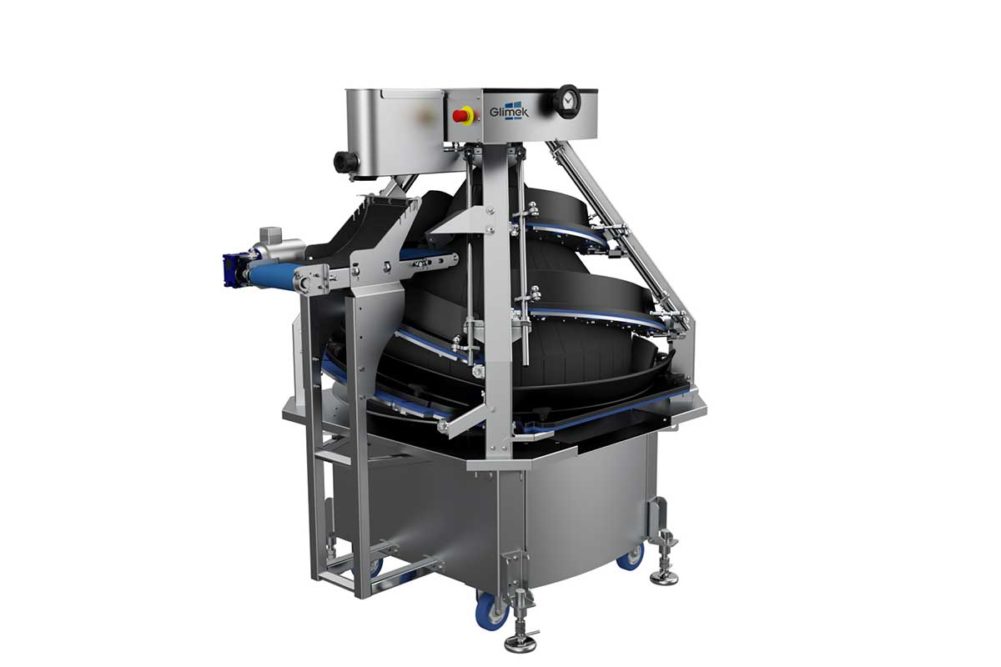Maintaining consistent dough temperatures will help dividing and rounding machinery run smoothly. This can be a challenge when temperatures in some bakeries can fluctuate wildly.
“If the bakery is not temperature controlled, then it is necessary to train the staff with the proper know-how regarding hydration and flour,” said Nate McDermott, director of customer service, WP Bakery Group USA. “By tweaking the hydration, adding additional flour in the flour duster, or sometimes even adding ice to the mix in place of some water content, you can keep the dough from sticking in the machine and achieve a great rounding/dividing result.”
When conditions change, the supervisor or mixer operator needs to adjust to maintain dough temperatures in the specified range.
“This can be done by adjusting chilled water temperature, refrigeration time on your mixer or the addition of ice if needed,” said Jim Fontaine, bakery field sales manager, Reiser. “Some bakers have chilled rounding beds, and this will also help control heat gain during rounding. You will also want to make sure your dough sizing is accurate in terms of running time. Just because you have a 2,000-lb mixer doesn’t mean you mix 2,000-lb batches that will take you 30 minutes to divide.”
Sticky, high-hydration doughs and doubles — when two dough balls merge — create problems for bakers, said Jay Fernandez, manager, Middleby Bakery Innovation Center. The nonstick coating, hot-air drying and a skirt on the tracks of the company’s conical Glimek rounders allow bakers to open the tracks and reduce contact surface, which results in less sticking. Controlling dough temperature is the most important step in ensuring the accuracy of dividers and rounders, he said.
“For today’s high-speed bread and bun systems, a chill bed will reduce heat and assist in keeping the dough ball cool,” Mr. Fernandez said. “In addition, formulas and ingredients vary greatly. The marriage of machine to dough rheology is key, so we would encourage testing in a controlled environment.”
Working with smaller batch sizes and keeping the levels of dough consistent in the hopper will help with equipment consistency.
“You always want to maintain a certain level of the dough,” said Ken Hagedorn, vice president of the bakery sector for Handtmann. “You don’t want to get the hopper to where it’s almost completely empty, then put another big load on top of it. We want to try to meter that dough to where it’s the same level because that always creates a certain back pressure.”
Some bakeries with big mixers don’t always invest in a dough metered system to feed the hoppers of the machine, which creates problems.
The use of extrusion dividers can neutralize the effect of changing dough conditions, said Bruce Campbell, executive product manager, AMF Flex, an AMF Bakery Systems brand.
“Maintaining the lowest level of dough possible in the hopper will also mitigate the temperature fluctuations for the environment,” he said. “This keeps dough in the mixer or chunker before it gets to the divider hopper where it can age quickly in a warm bakery.”
Rheon’s equipment is designed to work with doughs that are changing because of floor time and environment, said John Giacoio, vice president of sales, Rheon USA.
“Many of the products made on our lines are long fermented doughs, so changing dough conditions is what we deal with all the time,” he said. “Our systems are constantly monitoring the condition of the dough, and our dividers weigh each piece of scaled dough for accuracy. This weight information is sent back to the PLC, and the machine self-adjusts for optimal accuracy.”
This article is an excerpt from the October 2022 issue of Baking & Snack. To read the entire feature on Dividing & Rounding, click here.






